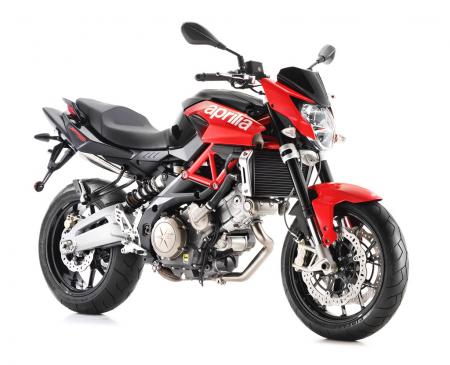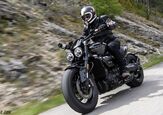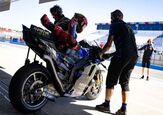2011 Aprilia Shiver 750 Review - Motorcycle.com
Have you ever found yourself not so impressed with someone after a brief introduction? Like, say, the proverbial mousy, slightly overweight girlfriend that a lot of hot chicks keep around as sidekicks.
A chance meeting a couple years after the first encounter reveals the sidekick girl dresses sexier now, has slimmed down some and is more fun than you initially gave her credit for. And you’re grateful she’s given you another chance.
That’s the context in which I’ve put the Aprilia Shiver 750.
When first I rode the SL750 two years ago I liked it enough, I guess. I couldn’t deny the Shiver’s friendly rider ergos or its array of technology, like three-mode rider-selectable engine mapping and throttle-by-wire. Yet, however practical the Shiver was, it simply didn’t turn me on.
I recently spent some time with the updated 2011 Shiver (same as the European 2010 model sans ABS) and came away from the experience with genuine admiration for the updated bike.
Go to hair and make-up, please!
Though the latest SL750 hasn’t received sweeping changes from the 2008/09 versions, the few changes it has are largely a result of Shiver customer input, according to Aprilia.
A narrower saddle, a new flyscreen, lower handlebars and rear-set foot controls are meant to impart a sportier feeling bike, while wave brake rotors, a narrower (5.5” vs. 6.0”) rear wheel and updated fuel mapping round out the technical upgrades.
I’d like to tell you the adjustments to the ergos serve as a vast improvement from what the first iteration of the Shiver offered, but the truth is I didn’t find the old dimensions a problem and so can’t say definitively the changes are of huge benefit.
What is a nice addition is the new color-matched flyscreen.
Though it doesn’t wrap the rider in a cocoon of still air, it nevertheless helps reduce some windblast compared to the old bike. In fairness, the fully naked Shiver of yore (okay, just one model year ago) did at least a decent job of deflecting wind via the headlight’s shape.
Maybe I simply didn’t spend enough time with Shiver 1.0, but after I pulled my first wheelie on the ’11 model I had to wonder what I missed the first time. How could I forget such a fun, grunty, ferocious 750cc V-Twin?
No changes are listed for the liquid-cooled, four-valves-per cylinder, DOHC, 749cc, 90-degree Twin, yet it made a different impression on me this time out.
And by different I mean it’s a barrel o’ monkeys to whack the throttle open, fan the clutch and try to contain the front-end. Also unchanged is the funky undertail exhaust, but here again I thought I should’ve remembered such a burly noisemaker providing a neat pop and burble on the overrun after you slam the throttle shut from higher rpm.
Despite my faulty memory, I still knew the Shiver came with three-mode mapping, and that although Sport mode gives the rider the full boil, it’s also pretty abrupt upon reapplication of the throttle. It’s interesting this little glitch remains in light of mapping updates that have otherwise smoothed throttle response and fueling from the previous model.
The solution to the somewhat snatchy fueling in Sport is to switch over to Touring mode, which still gives full peak power, but doles it out in smoother batches. And Rain mode is still there, of course, muting power considerably just as it did before.
The one thing I’d like to see eliminated from the mode switching procedure is the need for a fully closed throttle before mode changes take place.
While bombing down the interstate (or just about anywhere, really) I don’t care to decelerate to wait for the mode to switch, and then have to crank the throttle to catch up to where I once was. After all, it’s not like there’s such a great chasm of power between modes that the Shiver might suddenly rear up, whinny, and dump her unsuspecting rider. This isn’t a deal breaker by any means, just sayin’…
During dyno time the 2011 Shiver churned out 73 hp at 8800 rpm, putting it in the territory of Ducati’s newest air-cooled, two-valve Monster 796 that managed 76 hp at 8400 rpm when we recently tested it. However, the Shiver’s peak torque production of 44.3 ft-lbs at 7600 rpm is bested by the 796’s gruntier 53 ft-lbs at 6400 rpm.
New wave style rotors bring a more contemporary, if not trendy look to the Shiver, but they may have somehow improved braking performance. I recall the previous Aprilia-branded radial-mount calipers and stainless steel braided lines stopped the bike with force, maybe even with too much initial bite as Kevin noted in our 2008 Shiver review. But I also recall brake feel, well, lacked some feel.
According to Aprilia, brake pad material remains the same, so maybe it’s just my imagination, but feel seems to have improved.
Multi-point reach adjustments for the brake and clutch levers are nice, but reach to either lever is kind of long, even when set to the position offering the shortest reach. The standard position requires some pretty big mitts in order to stretch all the way out there to grab hold, so it’s a safe guess that lady riders who like the Shiver may look to the aftermarket for levers with more range, or a different range of adjustment.
The frame’s steel-tube trellis bolted to aluminum side plates also remains the same as before, as does the unadjustable 43mm inverted fork and linkage-less shock offering spring preload along with rebound damping adjustment.
Around these parts we tend to prefer the more progressive and linear action provided by shocks utilizing linkage. But at least accessing the Shiver’s inline shock is ultra easy compared to most bikes. And we have to think that offering at least spring preload for the front would seem on order for such a sporty bike like the Shiver.
According to Josh Kane, Technical Service Manager at Piaggio’s USA Costa Mesa, Calif., training and technical center, a couple simple adjustments to the Shiver’s suspension improve further the Shiver’s already admirable handling.
Raising the Shiver’s fork tubes to two lines showing above the triple clamp (stock shows no lines), and adjusting shock spring preload so that 27.5mm of threads show (stock is 9.7) followed by 8 clicks of rebound (from fully closed) instead of the stock setting of 11 is the ticket to even better steering response and overall handling.
Rear tire size of 180/55-17 remains from the first generation Shiver, but the 0.5-inch narrower rear wheel on the new Shiver creates improved triangulation in the tire’s profile, matching better with the front tire’s profile and is the key factor in the new Shiver’s improved steering and handling qualities.
The chassis does an excellent job of generating easy, linear steering while keeping this Italian machine tracking predictably through turns. A set of grippy Pirelli Diablo Corsa III tires keep it all glued to the asphalt.
Although it wasn’t a complete makeover, the Shiver received some useful treatments for 2010/11. But what’s stayed the same between the first Shiver and latest and greatest Shiver is its MSRP of $8999.
The Shiver can’t out-gun the Monster 796 in a battle of engine performance, but to get the Duc’s extra 10 ft-lbs you’ll need to shell out another $600 over the Shiver’s price tag to get the base model Monster.
When considering the Shiver offers the feature of switchable mapping, more upright, everyday livable ergos and overall performance that rivals the 796, you may find that relatively small price gap more appealing than it first seemed.
My recent re-acquaintance with the updated Shiver makes me think I’d look twice at the Shiver if I were in your shoes.
Related Reading
2008 Aprilia SL750 Shiver Review
2010 Aprilia Shiver 750 ABS Review
2010 Aprilia Mana 850 GT ABS Review
2009 Aprilia Shiver 750 GT ABS Review
2008 Triumph Street Triple vs. Aprilia Shiver
2010 Honda NT700V vs. Aprilia Mana 850 GT ABS
All Things Aprilia on Motorcycle.com
More by Pete Brissette



































Comments
Join the conversation